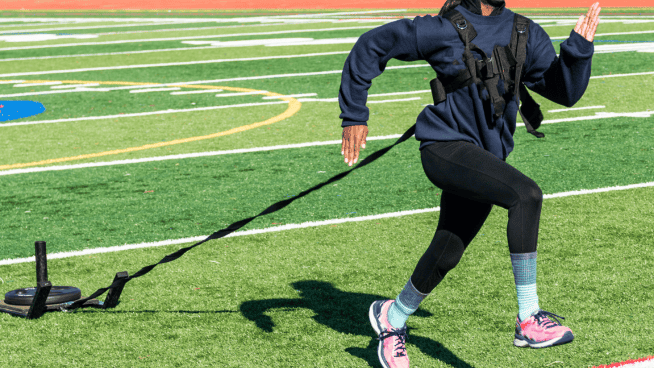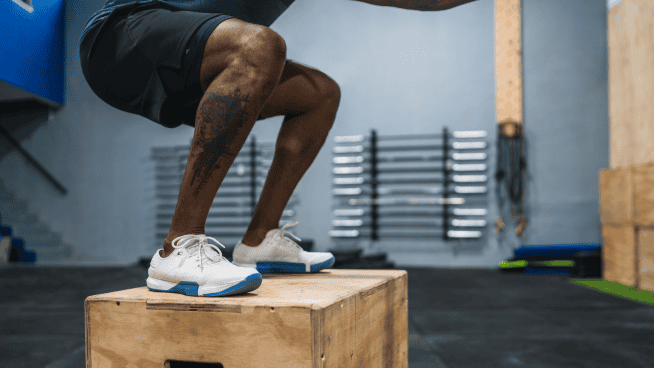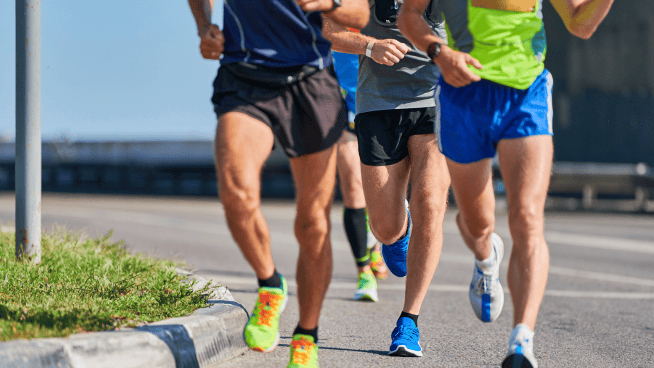The 5 Best Single-Leg Exercises for Soccer Players
Soccer is a game full of single-leg actions, and it still flabbergasts me when players fail to train balance and single-leg strength.
There is passing, shooting, jumping, decelerating, accelerating and changing direction—all movements that require players to be well-balanced, stable and capable of both producing and absorbing force on one leg.
- To have sharp agility and accelerate past a defender, players need to produce power off of one leg.
- To be resilient to injury and avoid that ankle roll or twisted knee, players need to absorb force on one leg.
- To have a shot with good technique and power, players need excellence balance on their plant leg.
- To run at high speeds, players need to put force in the ground one leg at a time.
It is clear that from an injury reduction and performance enhancement standpoint, soccer players desperately need single-leg training. But how should one go about it?
Here are five of my top single-leg exercises for soccer players.
1. Goblet Lateral Lunge
This much I know: Players need to move side to side more. Forwards and midfielders must perform fakes and jukes in the frontal plane to blast by defenders. Goalkeepers must be laterally explosive to dive and defend their goal. And defenders must side shuffle to better contain their opponents. A player’s inability to move well laterally increases their risk of injury, too.
The Goblet Lateral Lunge is a great exercise to strengthen the quadriceps, glutes and adductors—primary muscles involved in side-to-side movements like shuffling, diving and cutting. The Goblet rack increases the load on the anterior core, which improves core stability.
Perform 2-3 sets of 8-10 reps in each direction for hypertrophy. If the focus is on building strength, pair it down to 3 sets of 4-6 reps in each direction and consider using a heavier dumbbell.
2. Forward Skater Jumps
Building off that frontal plane strength, let’s develop frontal plane power, too. Incorporating plyometric movements in a well-rounded strength program optimizes rate of force development, or a player’s ability to be “explosive” when accelerating and maneuvering around defenders. Forward Skater Jumps are great to pair with the Goblet Lateral Lunge as a form of contrast training to improve post activation potentiation.
Perform 2-3 sets, each featuring 10-12 total ground contacts.
3. Goblet Split Squat
This is a nice alternative to Barbell Back Squats, as it still increases the strength of the quadriceps but in a manner that likely better translates to soccer athlete performance. Again, the Goblet rack adds the core stability component.
Perform 3-4 sets of 8-10 reps on each side for hypertrophy. To build strength, try 3-4 sets of 3-6 reps and consider using a heavier dumbbell.
4. Single-Leg Deadlift
Hamstring strains and ACL tears run rampant in soccer. With that said, if players are not doing Single-Leg Deadlifts, they are doing their bodies a major disservice.
Being able to control the hamstrings so players avoid these injuries is critical. Bulletproofing the posterior chain of the lower extremity improves the ability to absorb force from a rapid deceleration or change of direction.
There’s a big performance aspect of this, too. The hamstrings are a primary muscle group involved in shooting power, sprinting speed and jumping power.
For the Single-Leg Deadlift, perform 3-4 sets 8-10 reps each side for hypertrophy. For strength, try 3-4 sets of 3-6 reps on each side.
5. Standing Cross Crawl
Too often I ask players to balance on one leg for all but 30 seconds, only for them to fall over well short of that goal. A lack of balance without load is certainly an issue.
Though this looks like a mundane movement, the Standing Cross Crawl is a great exercise to use as warm-up to a lift or at the end of a workout when players are fatigued and need to dial in their focus to stay balanced.
I love the ankle dorsiflexion component here as well as the cross-body coordination.
Perform 2 sets of 10 reps on each side without losing balance. If you lose balance, start over.
These single-leg movements can be staples of soccer players’ routines. Mastery of them will help players become faster, stronger, more agile, more resilient to injury, and more confident in their movement.
Single-leg training is one of the best things soccer athletes can do to improve themselves now and ensure their bodies will stay strong for the long haul!
Photo Credit: vgajic/iStock
READ MORE FROM ERICA SUTER:
RECOMMENDED FOR YOU
MOST POPULAR
The 5 Best Single-Leg Exercises for Soccer Players
Soccer is a game full of single-leg actions, and it still flabbergasts me when players fail to train balance and single-leg strength.
There is passing, shooting, jumping, decelerating, accelerating and changing direction—all movements that require players to be well-balanced, stable and capable of both producing and absorbing force on one leg.
- To have sharp agility and accelerate past a defender, players need to produce power off of one leg.
- To be resilient to injury and avoid that ankle roll or twisted knee, players need to absorb force on one leg.
- To have a shot with good technique and power, players need excellence balance on their plant leg.
- To run at high speeds, players need to put force in the ground one leg at a time.
It is clear that from an injury reduction and performance enhancement standpoint, soccer players desperately need single-leg training. But how should one go about it?
Here are five of my top single-leg exercises for soccer players.
1. Goblet Lateral Lunge
This much I know: Players need to move side to side more. Forwards and midfielders must perform fakes and jukes in the frontal plane to blast by defenders. Goalkeepers must be laterally explosive to dive and defend their goal. And defenders must side shuffle to better contain their opponents. A player’s inability to move well laterally increases their risk of injury, too.
The Goblet Lateral Lunge is a great exercise to strengthen the quadriceps, glutes and adductors—primary muscles involved in side-to-side movements like shuffling, diving and cutting. The Goblet rack increases the load on the anterior core, which improves core stability.
Perform 2-3 sets of 8-10 reps in each direction for hypertrophy. If the focus is on building strength, pair it down to 3 sets of 4-6 reps in each direction and consider using a heavier dumbbell.
2. Forward Skater Jumps
Building off that frontal plane strength, let’s develop frontal plane power, too. Incorporating plyometric movements in a well-rounded strength program optimizes rate of force development, or a player’s ability to be “explosive” when accelerating and maneuvering around defenders. Forward Skater Jumps are great to pair with the Goblet Lateral Lunge as a form of contrast training to improve post activation potentiation.
Perform 2-3 sets, each featuring 10-12 total ground contacts.
3. Goblet Split Squat
This is a nice alternative to Barbell Back Squats, as it still increases the strength of the quadriceps but in a manner that likely better translates to soccer athlete performance. Again, the Goblet rack adds the core stability component.
Perform 3-4 sets of 8-10 reps on each side for hypertrophy. To build strength, try 3-4 sets of 3-6 reps and consider using a heavier dumbbell.
4. Single-Leg Deadlift
Hamstring strains and ACL tears run rampant in soccer. With that said, if players are not doing Single-Leg Deadlifts, they are doing their bodies a major disservice.
Being able to control the hamstrings so players avoid these injuries is critical. Bulletproofing the posterior chain of the lower extremity improves the ability to absorb force from a rapid deceleration or change of direction.
There’s a big performance aspect of this, too. The hamstrings are a primary muscle group involved in shooting power, sprinting speed and jumping power.
For the Single-Leg Deadlift, perform 3-4 sets 8-10 reps each side for hypertrophy. For strength, try 3-4 sets of 3-6 reps on each side.
5. Standing Cross Crawl
Too often I ask players to balance on one leg for all but 30 seconds, only for them to fall over well short of that goal. A lack of balance without load is certainly an issue.
Though this looks like a mundane movement, the Standing Cross Crawl is a great exercise to use as warm-up to a lift or at the end of a workout when players are fatigued and need to dial in their focus to stay balanced.
I love the ankle dorsiflexion component here as well as the cross-body coordination.
Perform 2 sets of 10 reps on each side without losing balance. If you lose balance, start over.
These single-leg movements can be staples of soccer players’ routines. Mastery of them will help players become faster, stronger, more agile, more resilient to injury, and more confident in their movement.
Single-leg training is one of the best things soccer athletes can do to improve themselves now and ensure their bodies will stay strong for the long haul!
Photo Credit: vgajic/iStock
READ MORE FROM ERICA SUTER:










